Session 2: Key Terms and Field Setup

Match Types
There are three types of matches that can be played in VRC Tournaments.
In a head-to-head match, two alliances (red and blue) each composed of two teams will play a 15-second autonomous period (pre-programmed) followed by a 1-minute 45-second driver controlled period.
There are two types of skills match that teams compete in as well. These are autonomous coding skills matches and driver skills matches.
In an autonomous coding skills match, one team with one robot will have 1-minute to score as many points as they can with pre-programmed commands.
In a driver skills match, one team with one robot will have 1-minute to score as many points as they can using their remote to control the robot.
The rules for skills matches are slightly different than the rules for regular head-to-head matches. These will be discussed in a different session.
Blocks
There are 88 blocks used in Push Back.
- 44 red blocks and 44 blue blocks
- 36 blocks start on the field in predetermined positions
- 24 blocks start in the loaders
- 24 blocks start in the alliance stations to be introduced as match loads by the drive teams
- 4 blocks (2 red and 2 blue) are used as pre-loads
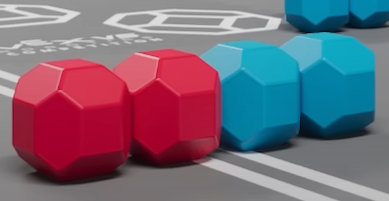
Goals
There are 4 goals where blocks can be scored. All of the goals can be used by any alliance.
- 2 long goals which hold about 15 blocks
- 2 center goals (upper and lower)
In addition to points being earned for each block scored in a goal, there are additional points awarded for controlling the goal. The long goals are controlled when the majority of blocks inside the control zone (space between the white tape lines) are the alliance’s color. For the upper and lower center goals, the control zone is the entire goal.
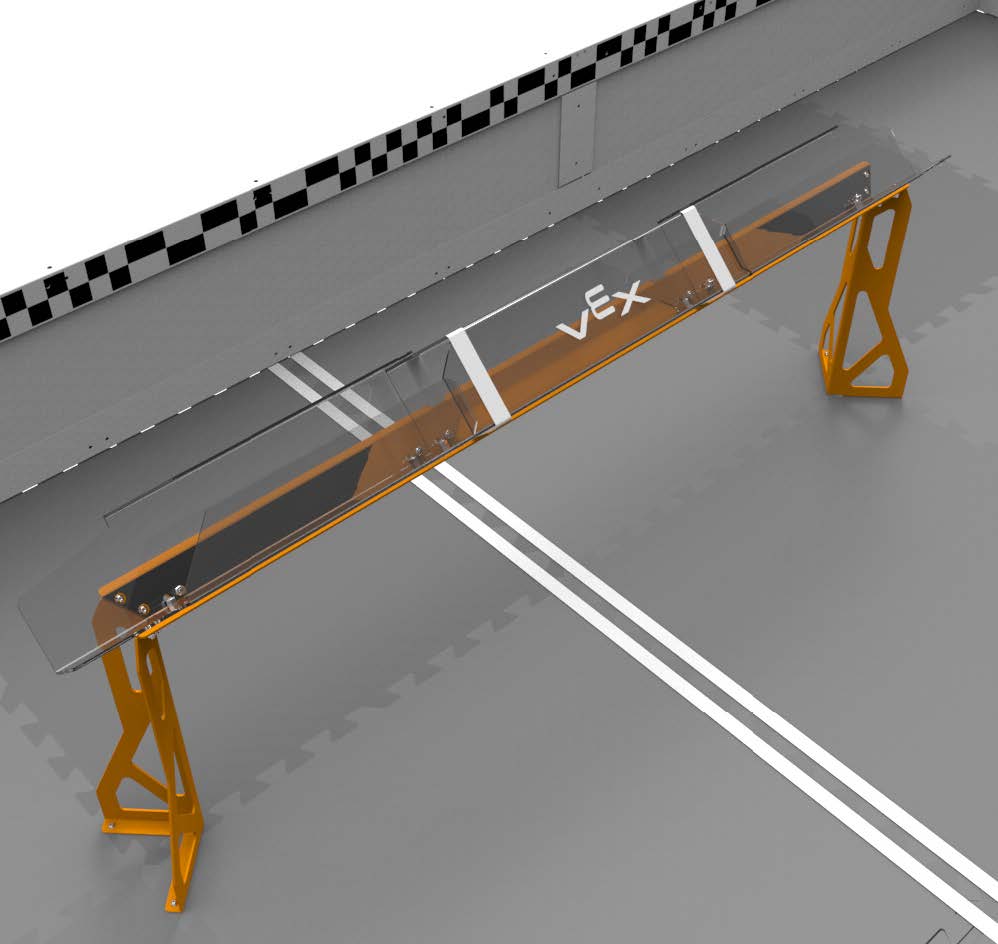
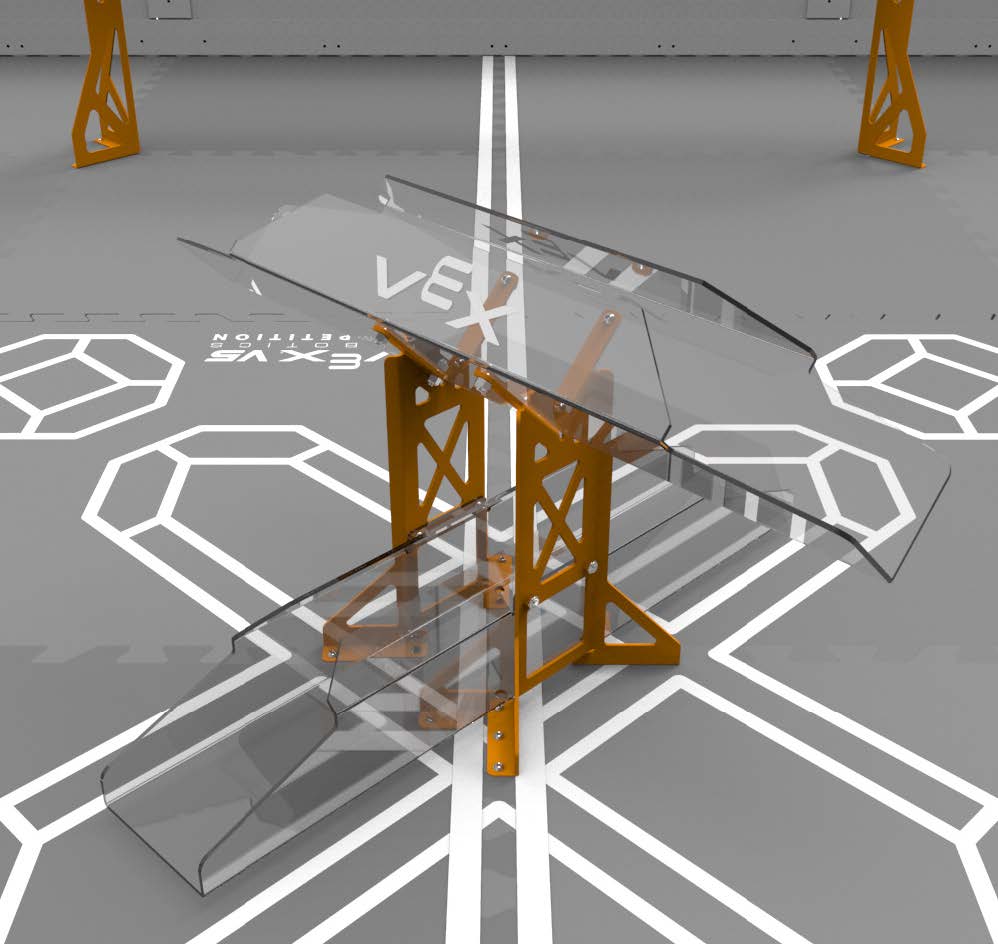
Park Zone
The park zone is the location where robots can park at the end of the match for additional points. Robots are considered parked if they are:
- not contacting the floor outside of their alliance-colored park zone
- not contacting any field elements other than the field perimeter, floor, and plastic park zone pieces
- at least partially within the vertical projection of the park zone
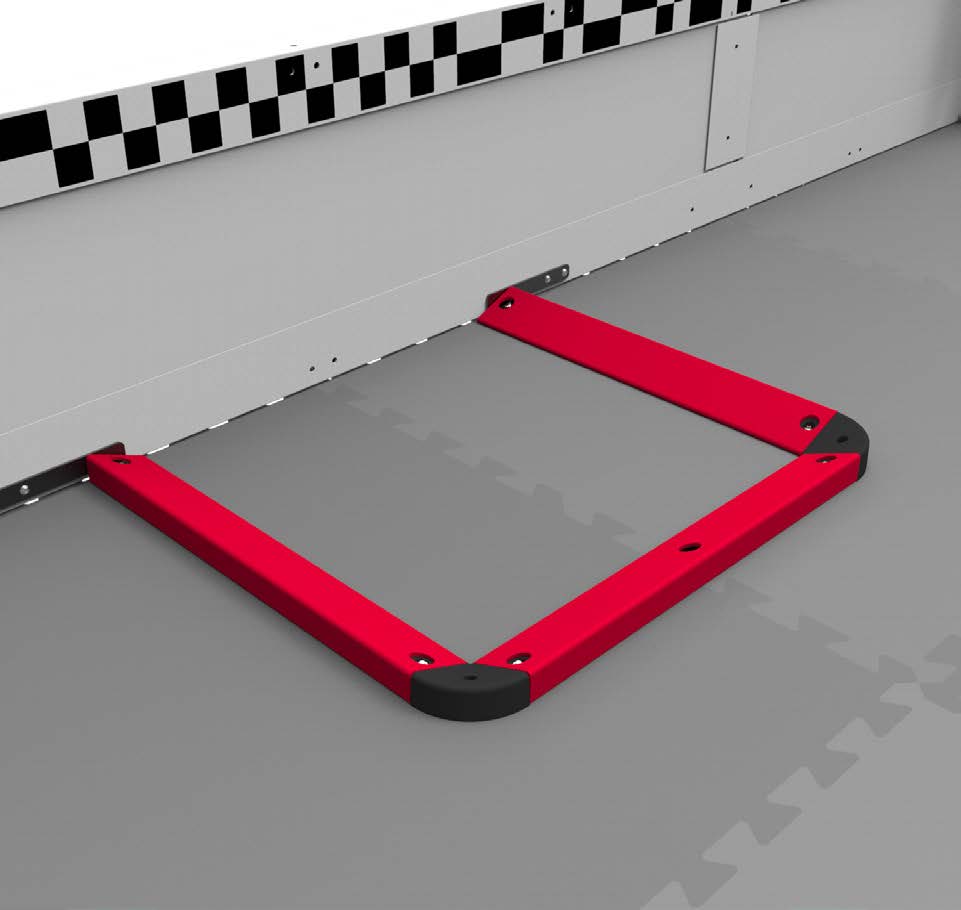
Teams and Alliances
Teams can be made of one or more students who compete together for a season. Team members can have many different roles (designers, builders, programmers, drivers, documenters). Adults cannot fulfill any of these roles.
An alliance is a pre-assigned group of two teams that are paired together for a given match at a tournament. Two teams will form the red alliance and two teams will form the blue alliance for each match. During qualifying matches, these alliances are randomly paired. Before elimination matches begin, teams will choose alliance partners who stay together for the remainder of the tournament.
Drive Team Members
Your team can have as many students as you wish. However, there can only be one, two, or three students from each team who stand in the alliance station during a match. These are called drive team members. These students do not all have to operate a controller. Some drive team members support the driver by keeping track of the time or what the opposing alliance robots are doing. Adults cannot be drive team members or shout instructions to drive team members during a match.
Field Layout
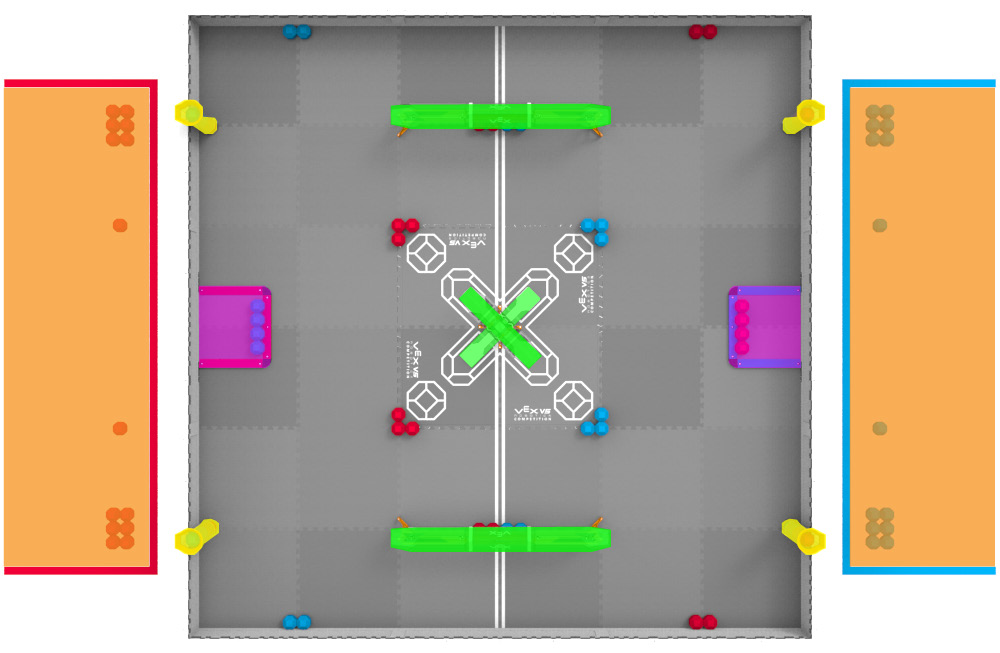
Up to three drive team members from each team can stand in the alliance stations (marked in orange) on the left and right sides of the field. The red alliance station is on the left (from the audience view) and the blue alliance is on the right.
The four goals are marked in green, the loaders are marked in yellow, and the park zones are marked in pink.
The starting positions of the 88 blocks are also shown (36 on the field, 24 in the loaders, 24 in the alliance stations, and 4 used as pre-loads.
Legal Starting Positions
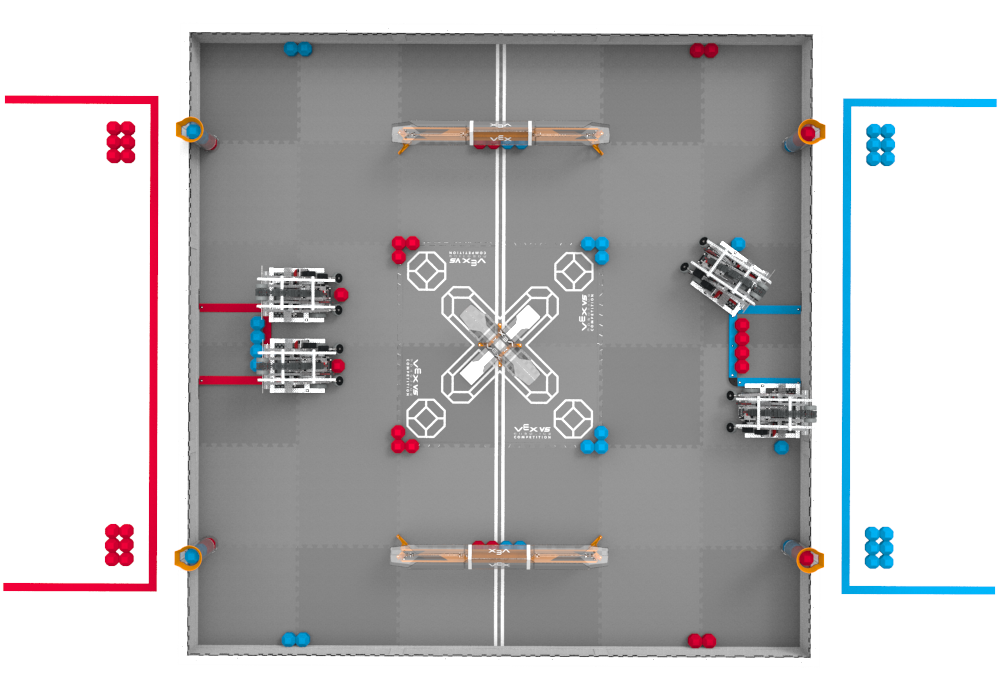
At the start of each match, alliance robots must be placed in a way that meets all of the following criteria:
- not touching any blocks other than the preload
- not touching any goal or loader
- no touching any other robot
- completely stationary
- touching the alliance park zone barrier
The robots must begin each match with dimensions smaller than 18″ x 18″ x 18″. They can expand once the match has started.
Preload Blocks
Prior to the start of a match, each robot will be allowed to use one of their alliance colored blocks as a preload. A preload is placed so that it is:
- contacting one robot of the same alliance color
- not contacting the same robot as another preload
- not touching (or within the volume of) a goal or loader
If a robot is not present for the match, that robot’s preload may used as a match load during the driver control period.
Autonomous Bonus
At the end of the 15-second autonomous period, once all blocks, field elements, and robots on the field come to a rest, the alliance with the most points will be awarded 10 points. In the case of a tie, each alliance will receive 5 points.
Points for parking are not considered when determining the autonomous bonus.
Robots cannot cross the autonomous line (the double white tape line running across the middle of the field) during the autonomous period. Doing so will result in the opposing alliance receiving the the 10 point bonus. If both alliances cross the line, no points will be awarded to either alliance. Also, robots cannot contact the blocks, field elements, or robots on the opposing alliance’s side unless the opponent is interacting with the autonomous line. This would result in the opposing alliance receiving both the 10 point autonomous bonus AND an autonomous win point.
Intentional, strategic, or egregious violations will be considered major violations and should result in a disqualification from the match.
Autonomous Win Point
Winning a qualifying round match gives each team in the winning alliance 2 “win points” to improve their overall ranking. (A tie gives each alliance 1 “win point”.) An additional win point can be earned by any alliance that completes four assigned tasks by the end of the autonomous period of a qualifying round match. To earn the autonomous win point (AWP) in Push Back, an alliance must do the following tasks without breaking any rules:
- score at least seven blocks of your color
- place blocks of your color on at least three different goals
- remove at least three blocks of your color from the loaders
- neither robot is touching the park zone barrier
Possession
A robot can carry, push, or plow an unlimited number of blocks.
Parking
Alliances can earn points by placing their robots in the alliance’s park zone at the end of the driver control period. During the last 20 seconds of a match, the park zones are protected and robots may not directly or indirectly contact the other alliance’s park zone or robots parked in that zone.
Violations:
A violation is any act which breaks one of the rules in the game manual. Usually, if something is not listed as a violation in the rules, then it is legal.
Minor Violations are any violation which does not result in a disqualification. These are usually accidental, momentary, or non match effecting violations. They usually result in a verbal warning from the head referee during the match which helps the team avoid it escalating into a major violation.
Major Violations are violations which do result in a disqualification. These are usually intentional or egregious rule violations which are clearly stated in the game manual. All match affecting violations are also major violations. Multiple minor violations within a match or tournament may be considered a major violation at the head referee’s discretion. The head referee will explain any major violations to the teams at the end of the match and issue the disqualification.
Match Affecting violations are ones which change who wins and loses a match. Once a match is complete and the scores have been calculated, if the team who committed the violation won the match and most likely would have lost if they had not committed the violations, they will be disqualified and the “losing” alliance will be awarded the 2 win points. In a qualifying round match, the alliance partner of the DQed team will also be awarded the 2 win points since it is not fair for them to be punished for the penalty of a randomly assigned partner. In an elimination round match, both teams on the alliance would be disqualified.
Disqualifications are always issued at the end of the match, never during.
The head referee will use the following flow chart to help determine if a violation is match affecting:
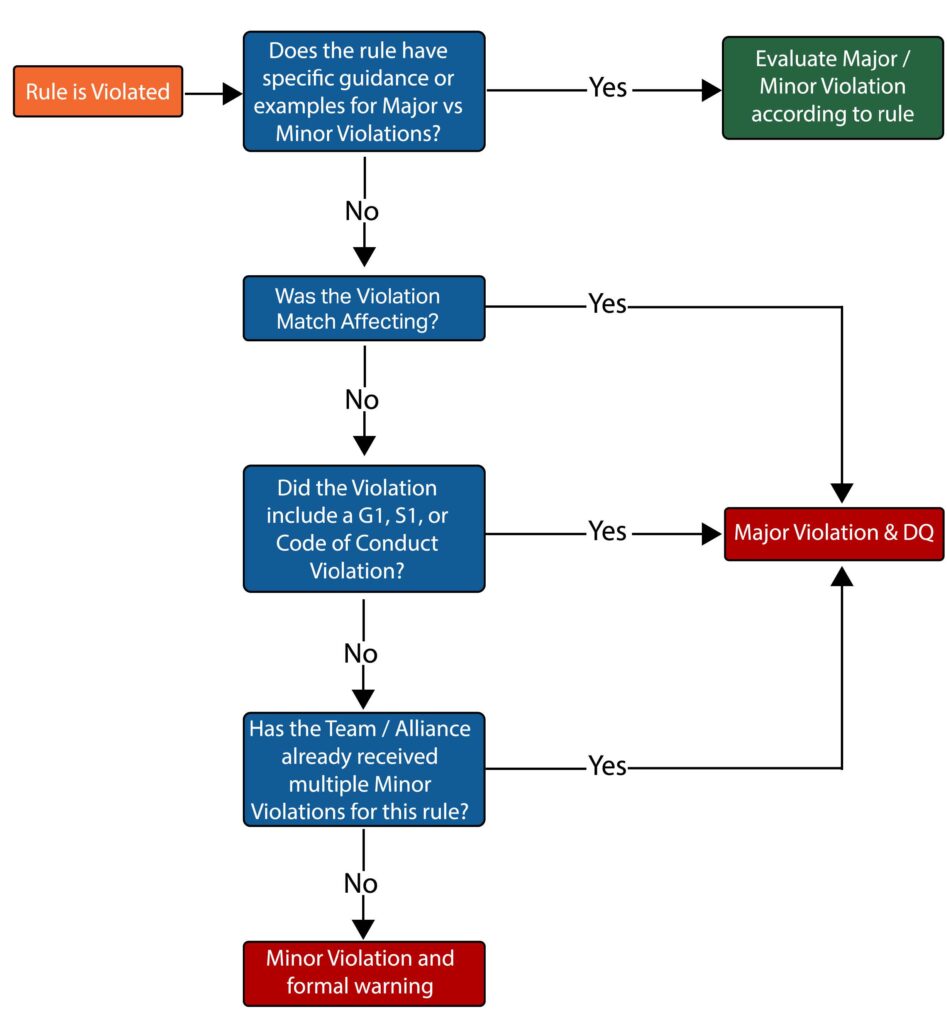
Safety Violations:
A disablement is a penalty issued to any team for a safety violation. A team that is disabled is not allowed to operate their robot for the remainder of the match, and the drive team member(s) will be asked to place their controller(s) on the ground.
If at any time it is determined that a robot or team ‘s actions are unsafe or have damaged a field element, scoring object, or the field, the offending team may receive a disablement and/or disqualification at the discretion of the head referee. Disabled robots will need to be re-inspected before taking the field in future matches.
A robot that is completely out of the playing field will be disabled for the remainder of the match.
Holding:
Holding is when a robot meets any of the following criteria during a match:
- trapping (limiting the movement of an opponent to a small area of the field without an avenue for escape)
- pinning (preventing the movement of an opponent through contact with the field perimeter, field or game element, or another robot)
- lifting (controlling an opponent’s movements by raising or tilting the opponent’s robot off of the foam tiles)
A robot may not hold an opposing robot for more than a 5-count. Once a count begins, the two robots must be separated by at least 2 feet for another 5-count. If a team resumes holding the same robot within this second 5-count, the original count will resume from where it ended.
Entanglement with another robot is not the same as holding. Some incidental entanglement may be expected, but intentional acts of grabbing, hooking, or attaching to an opponent robot may be deemed a major violation (and disqualification) at the head referee’s discretion.
A robot that is not attempting to move or escape is not considered trapped or pinned.
Assignment:
Go to the V5RC Drive Team Training Course and complete the Unit 1 Quiz.
If you miss any of the questions, now is the time to figure out why. Look back through the rules and the information listed in this session for clarification.
